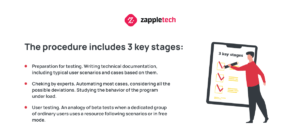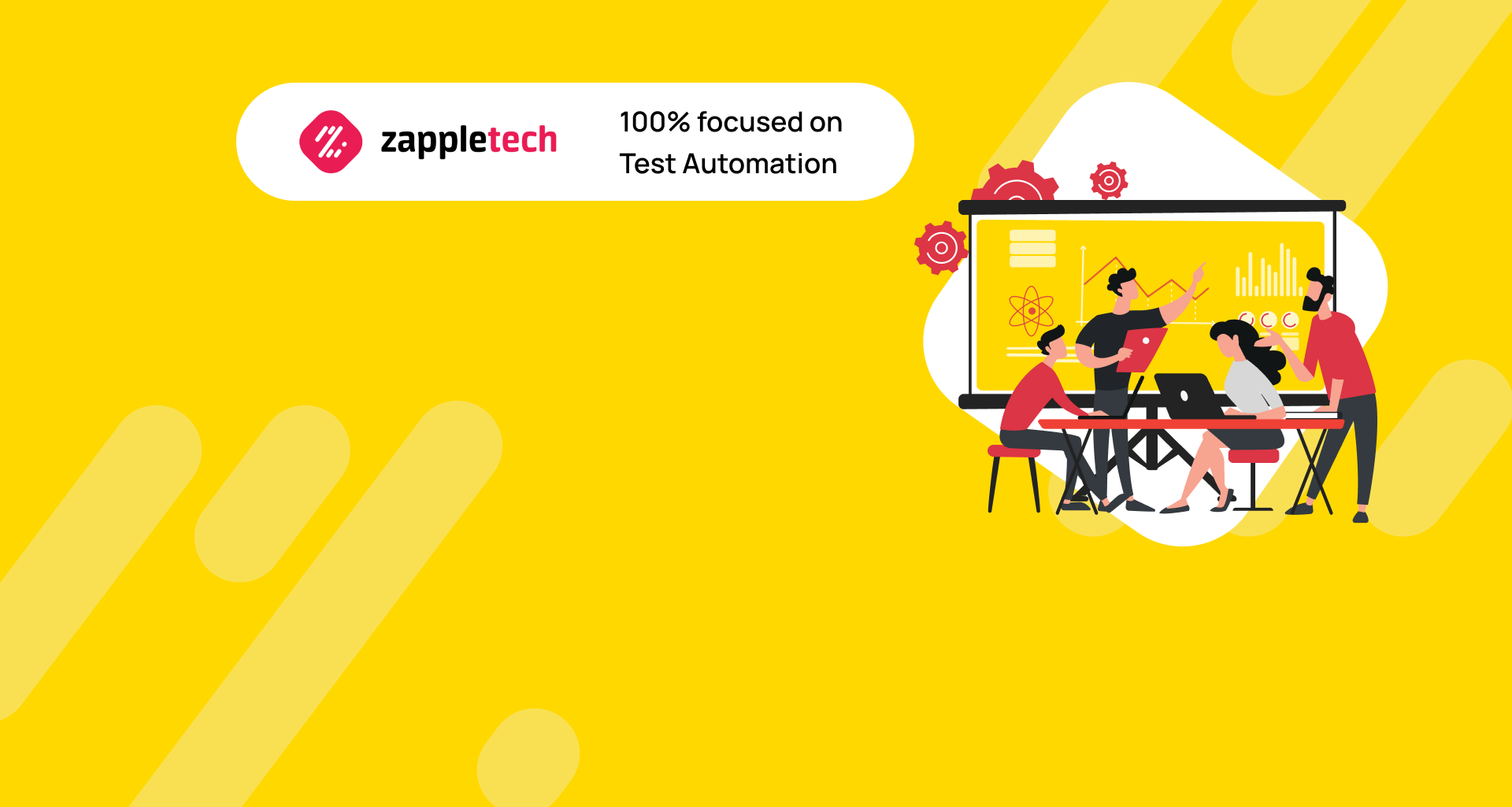Quality control of applications, games, or websites is an integral part of the development process. Regardless of the methodology selected (such as Agile, Scrum, or even Waterfall), checking the quality and performance of the project is vital before it is handed over to the customer. The GMInsight research confirms this, showing a positive trend in testing development. The QA services market has reached $40 billion in 2020, and, according to the same analytical group, the industry is expected to grow rapidly to $60 billion with a CAGR of 7% by 2027.
Use real-world scenarios that reflect actual use cases for the software. Testing under conditions that closely mimic how the software will be used in production helps uncover potential issues that might not surface during other types of testing.Mykhailo PoliarushCEO, ZappleTech Inc.
When it comes to the varieties of testing methods and stages, many experts list only the main ones. They focus on checks provided during the work on the product, forgetting about the final stages of quality control. ZappleTech conducted its own research on the QA services market and identified a key element that plays one of the most important roles when working on any IT product. From this article, you will learn what user acceptance testing is, its features, duration, and its key stages. We hope you enjoy the article!
Table of Contents
Terminology and nuances
What is UAT? User Acceptance Testing (UAT) is the pre-release and final stage of checking a desktop or mobile app/website for performance and critical bugs. It involves validating whether the software meets the business requirements and is ready for deployment. Typically, UAT is conducted in several iterations and requires the participation of both the QA team and third-party users. This phase is crucial because it focuses on real-world scenarios, ensuring the software’s usability, functionality, and overall quality before it goes live.
The term “acceptance” highlights the importance of real feedback from regular users, which forms the basis of testing. This user-centric approach helps identify any discrepancies between the intended functionality and user expectations. Automated User Acceptance Testing, or automated UAT, can also be implemented to streamline this process, making it more efficient and reducing the time required to go through multiple testing cycles. While manual testing relies on human interaction, automated UAT utilizes scripts and software tools to perform repetitive tasks, ensuring that the application behaves as expected under various conditions.
Understanding what is UAT and how it fits into the broader testing strategy is essential for any development project. Automated user acceptance testing, in particular, is beneficial in projects where frequent updates are released, as it allows for quicker identification of issues and ensures that the user experience remains intact with each new iteration.

Features
When we talk about all types of testing, we mean automating the main cases and checking the code, system, and interface. However, when it comes to acceptance testing, the situation is much more interesting, particularly with automated user acceptance testing (automated UAT). This kind of QA is always deployed at the final development stage when most problems are either fixed or not critical for users. A virtual environment and ready-made product builds with integrated data are used for checks.
What is user acceptance testing (UAT)? UAT, also known as automated UAT when performed using automation tools, is a crucial phase in the software development lifecycle where the software is tested in a real-world scenario by the intended users. The main goal is to validate the end-to-end business flow and ensure the system functions correctly from the user’s perspective. By incorporating automated user acceptance testing, businesses can efficiently streamline this process, ensuring consistency and saving time compared to manual testing.
The UAT environment plays a pivotal role in this process. But what is the UAT environment? It is a virtual environment that emulates the real conditions of using the product: entering data, creating accounts with limited access rights, and simulating the product’s interaction with internal and external databases. The environment helps to test the functionality safely, ensuring that all data is localized and protected. With the use of cloud technologies, all parties can connect to the deployed program and test it without uploading data to their devices.
Despite the extensive testing by specialists, users often identify issues more effectively and quickly. They intuitively explore how the app works and what they can do with it, sometimes causing unexpected situations that can disrupt proper functioning. These user-driven scenarios are highly valuable to developers because they reveal hidden problems that might not have been discovered otherwise. This highlights the importance of UAT and why automated UAT is becoming increasingly vital in modern QA practices.
How to provide such testing?
User acceptance testing (UAT) is a critical phase in software development that ensures the final product meets the end users’ needs and complies with business requirements. It is a systematic approach to validating the pre-release version of the Minimum Viable Product (MVP) for any critical errors and ensuring it aligns with the technical specifications outlined in the terms of reference (TOR). This type of testing, often referred to as UAT, is unique to each project due to the specific requirements of mobile, desktop, or web applications.
What is user acceptance testing? It involves both the customer and a dedicated team of testers who collaboratively validate the software’s compliance with business goals, user experience, and core functionality. The process is methodical and usually unfolds over six distinct stages, each designed to identify various types of potential issues.
Ensure that real end-users participate in the testing process. Their feedback is crucial as they are the ones who will be using the system daily. This helps identify usability issues and ensures the software meets user expectations.Sergey AlmyashevCOO, ZappleTech Inc.
In recent years, automated user acceptance testing has become increasingly popular as it allows for more efficient and consistent testing processes. By implementing automated UAT, teams can swiftly run tests against the application, ensuring that frequent updates or changes do not introduce new bugs or deviate from the defined requirements. Automated testing tools can simulate user interactions, validate functional behavior, and check for usability, all while saving significant time and resources compared to manual testing.
The key stages of UAT typically include planning, designing test cases, preparing the environment, executing tests, recording results, and evaluating the overall readiness of the product for launch. Each stage plays a crucial role in ensuring that the software not only meets technical specifications but also provides a satisfactory user experience. This thorough process helps to confirm that the software is ready for market release, reducing the risk of costly post-launch fixes.
Analysis
Firstly, you need to determine how the solution must work, its specifications, and ideas. This involves understanding what is user acceptance testing (UAT) and its role in the project lifecycle. User acceptance testing (UAT) is the final phase in the software testing process, where the software is tested in real-world scenarios by the end-users to ensure it meets the specified requirements. It is worth studying the technical documentation, developer reports, and tester cases to identify areas that require evaluation during UAT. In recent times, automated user acceptance testing has gained popularity, as it allows repetitive and complex tests to be conducted efficiently. Automated UAT streamlines the process, ensuring that the software performs consistently under various conditions. Usually, this work is delegated to contractors who review the product against expectations, specifications, and business models. Compliance with legislative norms and recommendations is also clarified at this stage, and all legal aspects are considered to ensure that the software meets all the necessary standards before it goes live.
Strategy
To ensure a successful software deployment, it is crucial to have a robust strategy for User Acceptance Testing (UAT). Understanding what is user acceptance testing is vital, as it is the final phase where actual users test the software to verify if it meets the business requirements. This phase is essential because it simulates real-world scenarios that the software will encounter once live.
The second step in this strategy is to develop and implement a UAT test script. By analogy with the roadmap, it outlines the roles of participants, the timing of the check, and the conditions required for a successful outcome or a decision to send the software for revision. This script is fundamental in automated user acceptance testing, which allows for consistent and repeatable testing processes, enhancing efficiency and accuracy. Automated UAT tools can be integrated into the workflow, enabling continuous feedback and reducing the time needed for manual testing, which addresses what is UAT in a modern, streamlined context.
Incorporating automated UAT not only speeds up the testing process but also ensures that tests are performed consistently under various conditions, identifying issues that may not be apparent through manual testing alone. As businesses increasingly look to optimize their testing strategies, understanding and implementing both manual and automated user acceptance testing becomes an invaluable asset in the overall quality assurance process.
Verification vector
When your plan is drawn up and put into operation, determining a verification vector is essential for guiding the testing process. A verification vector outlines the specific aspects of the product that need thorough examination, which typically aligns with the key requirements of the IT product. For example, if you are developing an e-commerce project, the primary focus would be on its core functionalities related to commerce, such as the catalog, shopping cart, search, payment processing, and customer communication. This approach ensures that the most critical components are tested first, reducing the risk of major issues later in the development cycle.
Understanding what is user acceptance testing (UAT) is crucial in this context. UAT is the phase where the product is tested by the end-users to validate whether it meets the business requirements and functions as intended in real-world scenarios. Often, automated user acceptance testing is implemented to streamline this process, allowing for quicker and more efficient validation of repetitive tasks.
Automated UAT uses predefined scripts to simulate user interactions with the application, verifying that the functionalities work as expected without manual intervention. This method not only saves time but also enhances the consistency and accuracy of the testing outcomes. By integrating automated UAT, teams can continuously verify changes and updates, ensuring that the product remains aligned with user needs and expectations throughout the development lifecycle.
Preparing cases
This process is almost the same as during development. When preparing test cases for user acceptance testing, it’s crucial to create a detailed description of the situation and clearly note the expected results that should be obtained after testing. The objective is to ensure that the product meets the needs and expectations of the end-users, making it essential for the cases to be straightforward and understandable, especially if ordinary users are involved in the verification. This approach is particularly relevant in automated UAT, where the automation of these cases can save time and reduce human error.
Understanding what is user acceptance testing (UAT) is fundamental to this process. UAT is the final phase of the software testing lifecycle, where real users test the product in real-world scenarios to validate whether it performs as intended. By implementing automated user acceptance testing, teams can streamline this phase, ensuring consistency and efficiency in validating the software’s functionality against the specified requirements. This approach allows testers to focus on broader testing strategies while ensuring all acceptance criteria are systematically met. Knowing what is UAT and how to effectively prepare for automated UAT is crucial for delivering high-quality software that aligns with user expectations.
Direct test
The acceptance test, often referred to as User Acceptance Testing (UAT), is based on the black box method. In this approach, testers evaluate the software without needing to understand its internal workings. Instead, they focus on performing actions and interacting with the system as an end user would, validating that it meets the specified requirements. This phase is crucial as it serves as the final stage before the project is handed over to the customer, ensuring that all functionality is thoroughly debugged and configured.
User acceptance testing plays a pivotal role in the software development lifecycle because it verifies that the product functions correctly in real-world scenarios and aligns with the user’s needs and expectations. When considering what is UAT, it encompasses tests designed to validate the system’s functionality, usability, and reliability from the user’s perspective.
Automated UAT, or automated user acceptance testing, is a more efficient approach where predefined scripts automatically execute UAT scenarios. This method reduces the manual effort involved in testing, accelerates the testing process, and improves accuracy. Although minor design flaws, internal glitches, and defects can be tolerated during UAT, the priority remains on uninterrupted operation and the compliance of the functionality with the specification.
Clearly outline what constitutes a successful test and what does not. This includes setting specific goals and requirements that the system must meet before it can be accepted. This clarity helps avoid misunderstandings and ensures the testing is focused on the right objectives.Mikhail BodnarchukCDO, ZappleTech Inc.
Studying the results
Upon completion of acceptance testing, you need to make a decision: to release the IT product to the market or return it for revision. The app’s productivity, readiness, and customer focus must also be evaluated. Based on the results, conclude documentation, which includes:
- program logs;
- user reviews;
- test plan;
- cases.
After testing is complete, conduct a UAT meeting. All interested parties should gather here: the customer, analysts, developers, and testers. Based on the results, the product may be sent for revision or published on the company’s website.
Let’s summarize
As you can see, acceptance testing is one of the most important steps in preparing an app for release. It involves verifying that the software meets the specified requirements and functions correctly in real-world scenarios, which answers the question, “what is user acceptance testing.” A critical aspect of UAT is ensuring the software’s usability, reliability, and performance under various conditions. This phase, often referred to as UAT or User Acceptance Testing, helps validate the readiness of an IT product, including its usability and stress resistance in any scenario.
While traditional UAT is essential, incorporating “automated user acceptance testing” can streamline the process, making it faster and more efficient. Automated UAT involves using tools and scripts to perform repetitive testing tasks, ensuring that changes in the software do not disrupt the intended functionality. The combination of manual and automated UAT helps in achieving comprehensive quality assurance, reducing the chances of errors slipping through to production.
ZappleTech has been testing systems of any complexity for over 10 years. We gathered experts in automation and manual testing of all popular technical stacks, providing a full spectrum of QA services, including automated UAT. By ordering services from our dedicated testing team, you can focus on your core business without being distracted by quality control. Our team will ensure that your product meets the highest standards, allowing it to start generating revenue immediately after the MVP is released. To get started with the best QA services, reach out to a ZappleTech specialist by contacting our manager.







